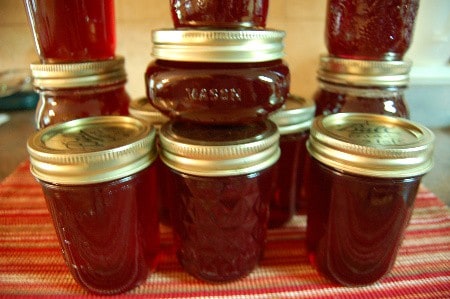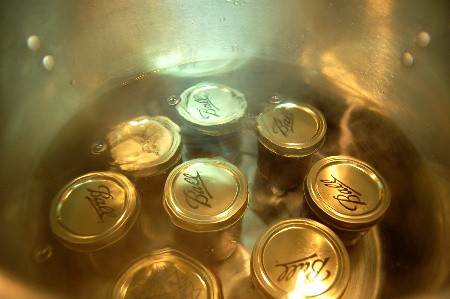Muscadine and Scuppernong Grape Jelly
Living in the lap of luxury at LilSis’ home, with electricity, TV, and high-speed internet has me spoiled and feeling somewhat guilty, since many of my friends are stuck in homes off the grid with generators running their box fans and refrigerators–local stores closed until further notice.
And so as not to feel like a totally spoiled slug, I joined Heather Here on a little jaunt to her father-in-law’s house to pick muscadine and scuppernong grapes.
We have no idea what all the rest of you were doing today, but this is what we were up to!
It was easy pickin’s, friends. And those grapes were gorgeous on the vines.
And since he came outside and told me he keeps up with the blog, I want to say here, “Thank you, Mr. J. for the beautiful fruit!”
The grapes almost fell off the vines into our hands.
Just look how thick and bountiful.
The cicada likes to cling to the old oak tree down the bayou, but in the big city, they seem to like muscadine vines!
And these are the golden scuppernongs. They have a unique flavor slightly different from the muscadines, but still very pleasant.
Both of these grapes make delicious jelly. And that is exactly what we did when we got home.
 The cast of characters . . . this time we used Sure-Jell to make our jelly.
The cast of characters . . . this time we used Sure-Jell to make our jelly.
First we rinse the fresh-picked muscadines
We measure the whole fruit following the Sure-Jell instructions and add 1.5 C of water.
The fruit then goes on the stove on high until boiling and then cover and simmer for 10 minutes. The skins burst open, releasing the grape juice.
The grapes are then put into a thin cloth (or cheese cloth) and hung over a bowl that catches the juice. Once the dripping slows, we squeeze the bag to get every last drop. Measure 5 cups exactly and pour into the cooking pot. Add the Sure-Jell packet and stir quickly to dissolve. Then cook on high heat, stirring constantly, bringing juice to a full rolling boil.
Next, quickly stir in 7 cups of sugar (which you previously measured in a separate bowl and set nearby.) Now return mixture to a full rolling boil while stirring constantly and then boil for one “timed” minute. Immediately spoon into hot jars and seal with hot lids and bands.
Now the jars go into the boiling pot, where they are covered by at least one inch of water and they boil for ten minutes.
Then remove the jars to a towel to cool and listen for the “POP” assuring you the seal is complete. Music to our ears!
We did this whole process 4 times and ended up with about 2 gallons of jelly. From the picking of the fruit to the jelly in this photo, we worked together for about 7 hours, and it will be worth every moment.
PBJ anyone?






















Just Jelly? Everyone I know here with muscadines also makes wine. Come to think of it, I actually think they make the wine, then make jelly with what muscadines they have left.
LOL! I can always count on my girl Steph! I don’t know how to make wine–besides I’m not that patient!
Could you share your wine recipe? I lost the recipe.
I’m not sure which recipe you’re talking about, Linda.
Dang…. another reason why I can’t figure out why I live up here….
I think they grow a bit south of me not sure but heard of them…
Just one more reason, huh?
Delicious on my English muffin this morning! And the last batch where we mixed the purple muscadine with the clear scuppernong came out a fantastic hot pink color.
Heather – It is scrumptious on RenRed’s biscuits this morning, too! We’ll have to take and display a photo of the two colors. Isn’t canning great? I mean, who in their right mind would pay $1.79 for a jar of grape jelly when you can have home-made muscadine instead?!!!
BW
The jellies are beautiful.
Glad you are all safe. Your hurricanes make our tornadoes look downright tame.
Hmmmm…..save me some seeds when your saving you some seeds. Which by the way are really good for you. And I’ll trade some CCDC”s for a jar of jelly. I am gonna tour the nursery sites for cultivars. PINK???
Hey!
What’s the latest on the condition of your home? Are you back there, or still in the safe house?
Love to you all, and I loved seeing the photos of the yummy fruits!!!
Blu – I’ll gladly trade you a jar of jelly for some CCDC’s!
Vance – We are upstate with my younger sister’s family. Power has not yet been restored to our bayou. Our homes suffered only some minor wind damage as far as we know–and no flooding, which is a MIRACLE!
We will stay here until we see what “Ike” is doing. My older sister has returned to her suburban New Orleans home with power and has invited us to go there, which is where we will go if Ike goes toward the Eastern Gulf and if we don’t have power down the bayou.
Can anyone please tell me what to do if my scuppernong jelly did not jell?
I added the sugar, then the pectin, & cooked for about 30 minutes before pouring into jars.
Now, I have poured all syrup back into the pot.
What to do now?
Thanks for any help you can give – Karmen
The same thing happened to my blueberry jam. the problem is the lack of acid in the fruit. Try adding 1/2 to 1 cup of lemon juice.
The recipe I use calls for 1 1/2 Tbs of Lemon Juice, Fresh Squeezed of course. Never had a problem.
Karmen, I am sorry to say that you’ve cooked it too long. You must absolutely only boil it for ONE MINUTE after you put in the sugar, as the recipe I use indicates. If you boil it too long, it will not jell. Now the syrup is just that–syrup. If you want to save it, jar it up, boil it in the hot water bath, and then use it as syrup on ice cream. I’m so sorry this happened to you. And I apologize for taking so long to answer, but I have been displaced due to flooding of my home from Hurricane Ike.
BW
Dear: Bayouwoman,
Loved your comments on making Muscadine jelly. We have a small vineyard and know the joys of raising and eating the delightful fruit. I usually sell my surplus grapes at a local flea market and find that many people don’t understand that all thick skinned seeded native southeastern grapes are Muscadines. Scuppernong is simply a variety of Muscadine. They are bronze in color but not a separate kind of grape from Muscadine. There are probably a few hundred different varieties of the Muscadine and one is the old bronze variety Scuppernong. Please help those of us who work with Vitis Rotundifolia clear the confusion. Scuppernong is only one variety or cultivar of the Muscadine grape family.
Thanks
Jess. thank you so very, very much for this clarification. I appreciate the fine details and will, at every chance, share this with others. Where is your vineyard? I would like to come get some. BW
I also have been picking Muscadines today and decided to search for new ideas on uses for them and stumbled onto you. Enjoyed reading this. I usually go by the grape recipe in the surejell package and will do that again this time.If you follow the directions exactly it usually doesn’t fail. The Muscadine is a beautiful fruit and smells so good, almost like wine. Have you ever made Elderberry jelly? That is good too.
Hi Linda, and welcome to the bayou. It’s good to hear from you. Where are you located? I have never made edlerberry jelly and not sure we have those here. I think I have seen some in the wild behind my home, but have never picked them. Tell me more! BW
I would gladly send you a jar of my Fig Chutney in trade for some Scuppernong and Muscadine seeds…I wonder if they would grow out here in the Arizona valley weather?
As a matter of fact, I will also send a jar of my peach jam!
Well, I love peach jam but have nothing with which to trade!!!
Well, I don’t have any seeds, and these vines are a 5 hour drive from me, so I can’t even send you a cutting. So sorry! I don’t know if they would grow in your Arizona valley!
Well, it was worth a try! Thanks anyway, & know that you have touched many lives here because of your wonderful recipes!
I used your recipe for figs and jell-o.
I followed it as described. There was no instructions on how to store the jelly or how long.
Please advise ASP.
Thank you
Mary Church
Thank you for teaching me how to can. I’ve canned fig preserves, strawberry fig preserves, peach preserves, vanilla honey peach butter, plum jelly and now muscadine grape jelly. Thank you for teaching me the joy of canning; I’m addicted :)))
You have been busy!! It is addictive, isn’t it? The rewards are so worth the work when you see the beautiful jars all lined up on the shelf! So proud of you, and thanks a million for taking the time to let me know!
live in south Louisiana. Are elderberries what we call coon grapes ?
I’m sorry Verbie, but I truly don’t know!!!
Ahoy – and happy new year! Seems “Coon Grapes”, are something else entirely. After some digging, I discovered they are the fruit o’ the “Alabama Supplejack”, a member o’ the Buckthorn Family – the technical name is Berchemia scandens. https://www.wildflower.org/plants/result.php?id_plant=besc
Not to be confused with Vitis Cinerea, (graybark grape) aka “Possum Grape” – an actual variety of grape. It has small black berries that are mildly unpleasant to eat. Plentiful in Missouri and Louisiana, it is also found throughout the eastern half of the US as far west as Texas, north to Illinois, and south to Florida.
Ah…but then I happened across a piece from Texas that referred to the American Beautyberry (I couldn’t make that up) – Callicarpa Americana – known locally as “Spanish Mulberry” or “Coon Grapes”. I guess if it’s small and round and Raccoons eat it…
Thank you for doing the homework, good Capt.! I absolutely know what American Beauty Berry is and have posted pics of them in a post!!
Your coin grapes are probably what we,in Florida call Fox grapes